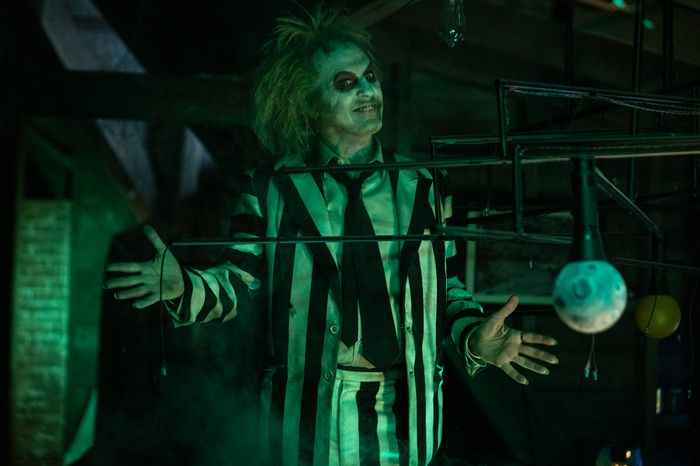
Midway through Beetlejuice Beetlejuice, Delia Deetz (Catherine O’Hara) demands to know “where’s the obnoxious little goth girl who tormented me all those years ago?” The flamboyant conceptual artist is talking to her stepdaughter, Lydia (Winona Ryder), who’s grown from the morose teenager of Beetlejuice (1988) into the middle-aged star of a hokey ghost-hunting reality show. But you get the feeling that this is a question director Tim Burton could just as well be posing to himself. The original film was born out of the hectic creative heyday Burton had in the ’80s and ’90s, before he got mired in moribund Disney remakes and bewildering adaptations starring (an otherwise great) Eva Green. Like his character Lydia, who describes what she’s done as selling out, Burton passed from a youthful infatuation with darkness into more grown-up concerns, among them whichever one made 2019’s Dumbo seem like a good idea. Beetlejuice Beetlejuice is in some ways itself a product of those concerns, both as a 36-years-later sequel and as a story about how Lydia has since stepped into the position of the distracted parent who’s unable to connect with their own moody child. And yet somehow there’s nothing cynical about it. Beetlejuice Beetlejuice is, instead, a return to form that finds Burton and much of the previous cast getting weird, gross, and, yes, goth in both an idyllic New England town and a gleefully bureaucratic afterlife.
In the first Beetlejuice, monied New Yorkers were just as much the antagonists as the fast-talking ghoulie of the title (sort of — he’s technically “Betelgeuse” in that film). The Deetz family first arrive in Winter River, Connecticut, full of condescension, resentment, and some regrettable approaches to remodeling, and it feels entirely in character that by Beetlejuice Beetlejuice, they appear to have partially or entirely returned to the city. Lydia, who’s kept the distinct spiky bangs while graduating to more Elvira-esque dresses, plays “psychic mediator” in front of a live studio audience while her producer and boyfriend, Rory (an oily Justin Theroux), hovers nearby. Her daughter, Astrid (Jenna Ortega, made for this), is ensconced in a boarding school where she heads up a doomer-y climate club. Delia has become a Manhattan art star, if her gallery-wide show, “The Human Canvas,” is any indication. The death of her husband, Charles, is both the inciting incident and a handy way of dealing with the fact that the actor who originally played the man, Jeffrey Jones, is now a convicted sex offender — he gets his head bitten off by a shark and spends the rest of the film as a walking torso. Charles’s funeral provides an excuse for the three women to return to Winter River, where, in the course of cleaning out the house, they come back into contact with a certain foul-mouthed spirit who’s still holding a candle for Lydia, the one who got away.
Running through Beetlejuice Beetlejuice is the fitting theme of shaking off malaise, whether that comes in the form of lingering grief (Astrid’s father, played by Santiago Cabrera, died not long after he and Lydia split), romantic inertia (Rory hides his manipulations behind therapyspeak), or supernatural hauntings. While Michael Keaton slips zestfully back into the role of Beetlejuice like he never left, and the always reliable O’Hara is spookily unchanged, Ryder plays Lydia, poignantly, as a brittle adult who’s stuck dressing in the style she affected a few decades ago, as though she’d gotten interrupted before she could fully finish growing up. When she begs Rory for one of her pills to get through the day, it’s a moment that’s just on the edge of being a little too real, but the movie otherwise wears its emotional allegories lightly. Lydia may have some unfinished trauma from the past that she has to exorcize, but she also has actual ghosts to contend with. When Astrid, a devout nonbeliever, meets a dreamy neighborhood boy named Jeremy (Arthur Conti), she learns that her mother isn’t delusional about all the visions she claims to have after all, and soon the characters have to enlist the help of a fiend whose name they never wanted to speak again (much less say three times). In there, also, is a stop-motion sequence, undead hallways at impossible angles, all the cleverly mangled waiting-room corpses imaginable, and the amusing but poetic visual of the Deetz house cloaked in a mourning veil. It’s all rendered in scenes that lean heavily on practical effects (including a demonic baby Beetlejuice that crawls across the ceiling à la the detox scene from Trainspotting).
If that sounds like an odd, lopsided plot, well, the first Beetlejuice lurched along to its own idiosyncratic calypso rhythms too. Beetlejuice Beetlejuice trades that Caribbean beat in for a disco one that works startlingly well, maybe because it matches the film’s jolting energy. When Monica Bellucci, playing Beetlejuice’s soul-sucking ex Delores, staples the chopped-up chunks of her body back together to the sound of the Bee Gees, it’s a gruesomely jubilant sequence. And when the film arrives at a lip-synced version of “MacArthur Park,” there’s genuine joy to the way the musical number is staged. So many recent revisitations of old properties play like corporate attempts to reanimate the dead — literally, in the case of movies like Ghostbusters: Afterlife and Alien: Romulus. But Beetlejuice Beetlejuice manages to avoid the feeling that its only obligation is to dutifully run through everything familiar one more time. Instead, watching it is a small but significant relief, like reconnecting with an estranged friend and finding out that you still get along after all — and for more reasons than just shared history, back when you were both obnoxious little goth girls.
More From The Lido
- Luca Guadagnino’s Queer Is More Challenging Than You Might Expect
- Julianne Moore and Tilda Swinton Are Perfectly Imperfect Together
- A Minute-By-Minute Breakdown of The Brutalist


